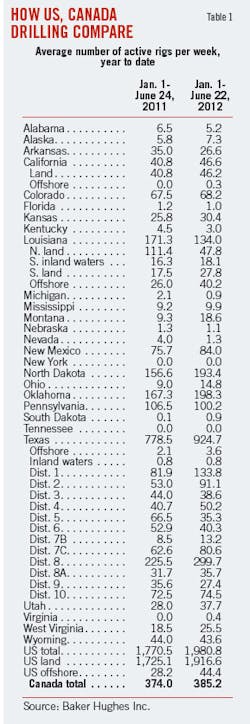Weak oil prices threaten after strong US first half drilling
Sagging crude oil prices have joined anemic natural gas prices to cloud the outlook for US and Canada drilling in the rest of 2012. As so many operators have steered capital spending away from dry gas drilling towards plays in formations with predominately oil and NGL, liquids production has risen rapidly, helping to depress liquids prices.
Rig activity in the US was 12.4% higher in the first half of 2012 than the same period of 2011 (Table 1), but if the drop in oil prices persists operators could begin drilling fewer wells later this year. Continued drilling to hold leases in the face of lower oil prices, as happened with the shale gas plays, is also possible.
The American Petroleum Institute reported 28% fewer gas well completions in the 2012 first quarter than in the first 3 months of 2011.
Here are highlights of OGJ's midyear drilling forecast:
• Operators will drill 44,522 wells in the US, down from an OGJ-estimated 46,177 wells in 2011.
• All operators will drill 2,140 exploratory wells of all types, down from an estimated 2,231 last year.
• Operators will drill 12,030 wells in Canada, down from an OGJ-estimated 13,145 wells in 2011.
Internationally, the rig count was up 8% year to year to 3,589 rigs/month in January-May 2012 with almost all of the gains evident in the Middle East, Mexico, and Brazil (Table 2).
OGJ's drilling forecasts
If US operators wish to slow their 2012 drilling programs, they don't seem to have begun to apply the brakes in the first half of the year.
Baker Hughes counted an average of 1,982 rigs/week actually making hole in the first half of 2012 through the first week in June, and the June 15 count held at 1,971 rigs. That compared with a 2011 first half average of 1,762 rigs/week. As late as June 22, 1,966 rigs were working.
OGJ suggested in January 2012 that operators would move rigs that formerly drilled for gas over to work on liquids-prone prospects and that the overall rig count would not decline this year due to the slowdown in gas drilling. That appears to have been what occurred in the first half.
But with oil prices having trailed off during most of the first half, OGJ's January 2012 forecast that the rig count would average 2,010 rigs/week and operators would drill 48,200 wells this year now appear to have been optimistic.
Plays and capital programs
One positive indicator for future US drilling was participation in the June 20 Gulf of Mexico federal lease sale (OGJ Online, June 20, 2012). However, it will take much of the rest of this year before high bids are approved and operators can mount drilling programs there.
Furthermore, Baker Hughes data showed only 40 rigs/week working off Louisiana and 4 rigs/week off Texas in the first half of 2012. The rig count isn't specific to water depth, but shelf tracts drew more bids than did deepwater blocks at the sale.
Not all gulf operators decided to bid. Petroleo Brasileiro SA, which started oil production at Cascade deepwater Lower Tertiary oil field in late February 2012 with the gulf's first floating production, storage, and offloading vessel, made no bids on its own or with others.
Among the more active onshore areas, meanwhile, about 250 rigs have been at work in the first half of 2012 in the South Texas Eagle Ford shale play and more than 400 rigs in multiple West Texas plays.
Tight oil plays in western Oklahoma have swelled that state's first half average to 199 rigs, even more than the North Dakota average of 193. Montana's first half average of 18 rigs/week is more than double that of first half 2011 on the strength of Bakken and Heath shale oil plays.
A sharp drop in Haynesville/Bossier gas drilling cut North Louisiana drilling more than in half to 49 rigs/week and adjacent East Texas Dist. 6 to 41 rigs from 53. Arkansas gas drilling also fell.
West Virginia averaged 26 rigs/week compared with 18 a year ago, Ohio fielded 14 rigs versus 9 as Utica shale drilling picked up, while Pennsylvania fielded 102 rigs/week, down from 106.
Canada's outlook
Canadian drilling slipped in the first 5 months of 2012 while international drilling outside the US and Canada saw a double-digit increase.
Canadian operators rig-released 12,877 wells in western Canada in 2011, said the Canadian Association of Oilwell Drilling Contractors. Canada's active rig count has fallen 16% on the year to average 322 rigs/week in January through May, Baker Hughes reported.
CAODC at the end of May reduced its forecast of Canadian drilling to 11,834 wells from 12,672 wells, citing the added time needed to drill increasingly complex horizontal wells.
More Oil & Gas Journal Current Issue Articles
More Oil & Gas Journal Archives Issue Articles
View Oil and Gas Articles on PennEnergy.com

Alan Petzet | Chief Editor Exploration
Alan Petzet is Chief Editor-Exploration of Oil & Gas Journal in Houston. He is editor of the Weekly E&D Newsletter, emailed to OGJ subscribers, and a regular contributor to the OGJ Online subscriber website.
Petzet joined OGJ in 1981 after 13 years in the Tulsa World business-oil department. He was named OGJ Exploration Editor in 1990. A native of Tulsa, he has a BA in journalism from the University of Tulsa.


